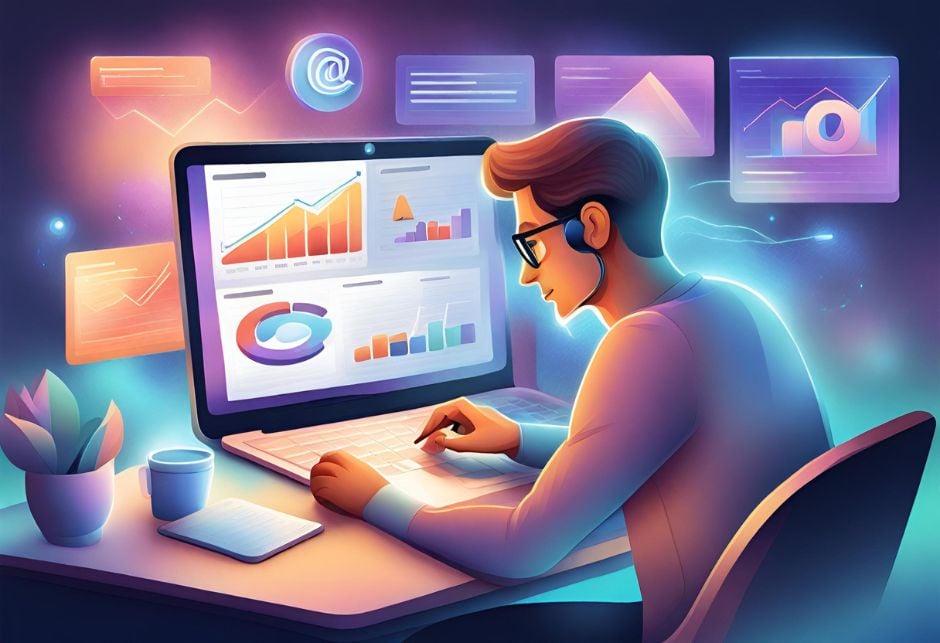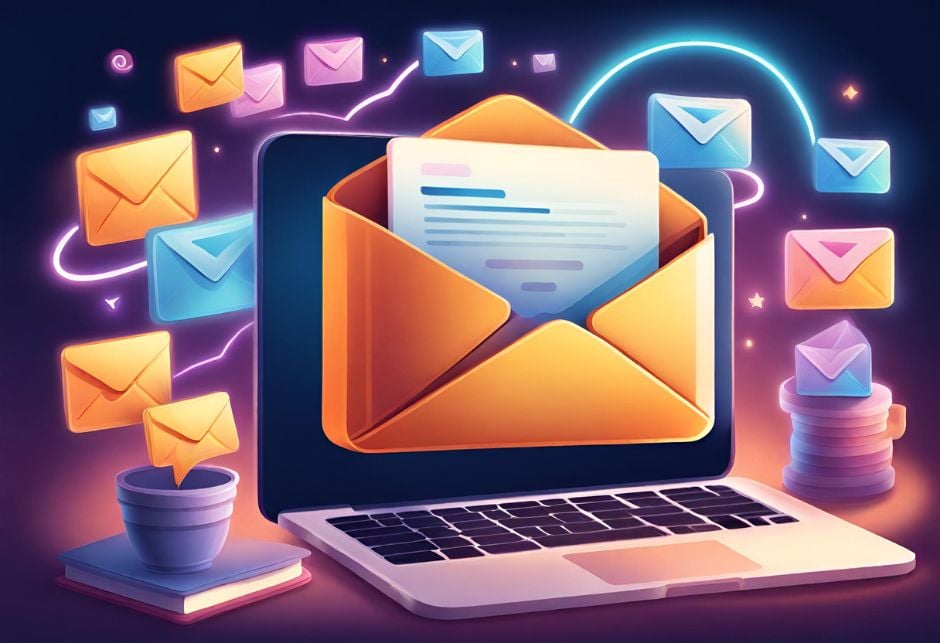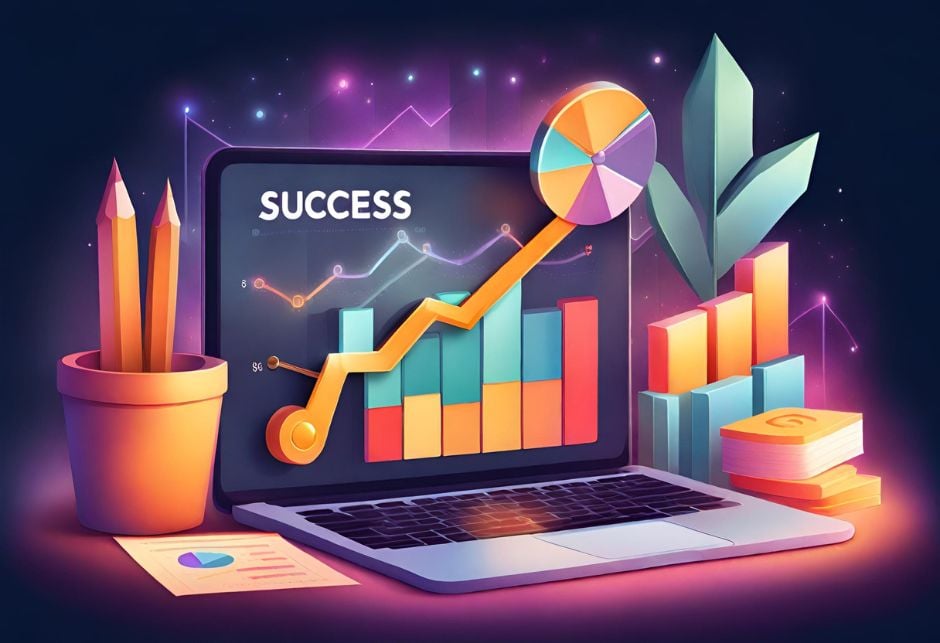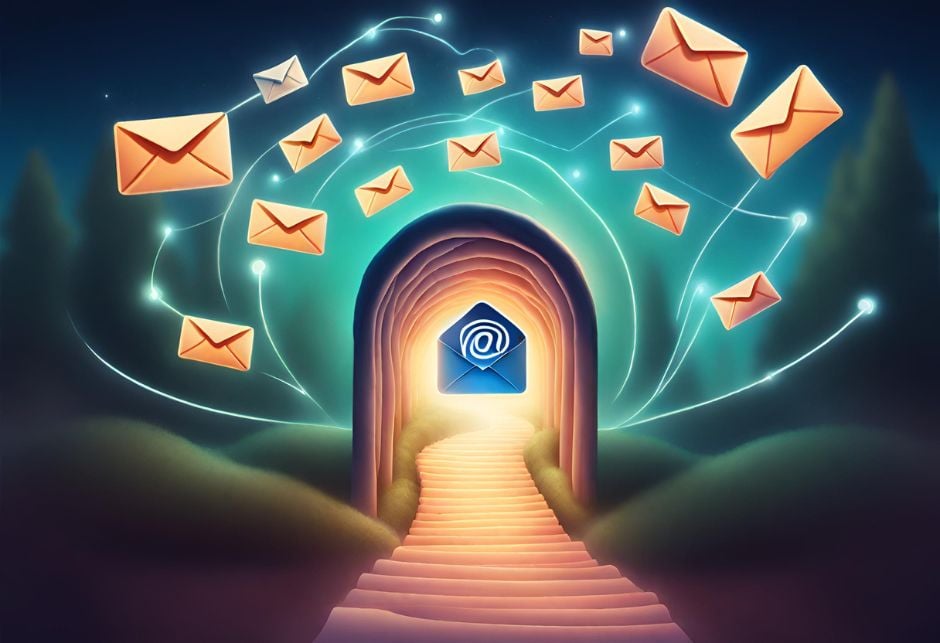Unlocking the Power of Digital Communication

An email marketing guide is a powerful tool in the digital marketing arsenal, particularly for startups. It involves sending emails to a list of contacts who have opted in to receive communications from your company. Using email in your marketing strategy serves multiple purposes, from building relationships with prospects and customers to promoting products or services.
Startup email marketing strategy is incredibly crucial for new businesses. It offers a cost-effective way to reach a broad audience, provides measurable results, and enables personalized communication. Unlike many other marketing channels, email marketing allows direct interaction with your target audience, facilitating the development of a loyal customer base essential for long-term success.
The Evolution of Email Marketing and Its Relevance Today
In this step-by-step email marketing guide for entrepreneurs, we'll explore how startup email marketing has come a long way since its inception. Initially, it was a form of direct mail, digitalized. However, with technological advancements and changes in consumer behavior, email marketing has become a sophisticated tool. Today, it's about crafting engaging, relevant, and personalized content that speaks directly to the interests and needs of the recipient.
The relevance of email marketing today cannot be overstated, especially for startups. In the age of information overload, email remains a preferred channel for many consumers to receive updates and promotions. Its adaptability to mobile devices also enhances its effectiveness, as a significant portion of emails are read on smartphones and tablets.
Email marketing for startups is not just about sending emails; it's about building relationships, fostering trust, and delivering value to your audience. It is an indispensable tool for startups looking to establish a strong market presence that combines efficiency, cost-effectiveness, and a personal touch.
Understanding the Audience

Identifying Your Target Audience: Who Are They?
Before we get to email marketing tips to grow your startup fast, first - a deep understanding of your target audience is the foundation. This is required before you start any lead generation through email marketing. For startups, identifying who your audience is involves analyzing various demographics, interests, and behaviors. This process is crucial because it dictates your emails' tone, content, and timing.
Start by creating ideal client profiles and buyer personas - semi-fictional representations of your ideal customers based on market research and actual data about your existing customers. Consider age, location, job title, income level, and personal challenges. For instance, HubSpot shows that emails tailored to specific buyer personas can increase click-through rates by 14% and conversion rates by 10%.
How to Create Buyer Personas
Gather Data: Collect data from your current customer base. Use your CRM, survey responses, social media analytics, and website traffic data. Look for patterns in demographics, behavior, and engagement.
Interview and Survey: Conduct interviews or surveys with your current customers. Ask about their challenges, goals, preferred communication channels, and feedback on your products or services.
Analyze and Identify: Analyze the collected data to identify common characteristics. Look for shared pain points, interests, or needs.
Create Detailed Personas: Create detailed profiles for each persona. Include demographic information (age, occupation, location), psychographics (interests, values), and behavioral traits (buying patterns, preferred communication channels).
Name Your Personas: Give each persona a name and a face (a stock photo or an illustration). This humanizes them and makes them easier to reference in marketing discussions.
Review and Refine: Regularly review and update your personas as your business grows and you gather more data.
We like HubSpot's free and fun Make My Persona tool for this.
Email Segmentation for Startups - Optimizing Your List for Maximum Impact
Once you know your audience, the next step is creating and segmenting your email list. Segmentation is dividing your email list into smaller groups based on specific criteria. This allows for more targeted and personalized email campaigns.
According to a study by Campaign Monitor, marketers have noted a 760% increase in email revenue from email segmentation! Startups can segment their lists based on criteria like purchase history, engagement level, or demographic information.
Effective list building and segmentation lead to more relevant and engaging email communication, resulting in higher open rates, better click-through rates, and increased customer loyalty.
How to Segment Your Email List
Define Segmentation Criteria: Based on your personas and business goals, define criteria for segmentation. This could be demographic information, purchase history, engagement level, or stage in the sales funnel.
Use Your Email Marketing Software: Utilize the segmentation tools provided by your email marketing software. Most platforms allow you to create segments quickly based on your data.
Segment Based on Behavior: Create segments based on user behavior, such as website activity, email engagement (opens, clicks), and purchase history. For instance, you could have a segment for users who frequently open emails but haven’t made a purchase.
Test and Optimize: Continuously test and refine your segments. Monitor the performance of your email campaigns in each segment to see what works best.
Keep Segments Dynamic: Ensure your segments are dynamic, automatically updating as changes occur in people’s behaviors or profile information.
Creating buyer personas and segmenting your email lists lays a strong foundation for personalized and successful email marketing campaigns.
Foundations of Email Marketing

How to Start Email Marketing for Startups: 5 Components of Effective Strategies
Effective email marketing campaigns are built upon several key components:
-
Clear Objectives: Define your goal with each campaign. Objectives could range from increasing website traffic to boosting sales or improving customer retention.
-
Engaging Content: Your emails should offer value to the recipient, whether it’s informative content, exclusive offers, or entertaining stories. Keep the content relevant to the audience’s interests and needs.
-
Attractive Design: A visually appealing email can significantly increase engagement. Use a responsive design that works well on both desktop and mobile devices.
-
Strong Call-to-Action (CTA): Each email should have a clear CTA, guiding recipients on what to do next – purchasing, reading a blog post, or signing up for a webinar (based on your objective).
-
Personalization: According to Experian, personalized emails deliver 6x higher transaction rates. Beyond just using the recipient’s name, tailor content based on their preferences and behavior.
💡 We will dive deeper into these components later in this guide, but for now -- keep them as a mental checklist of email marketing best practices.
The Role of Design and Content in Email Marketing
The design and content of your emails play a critical role in the success of your email marketing efforts:
-
Design: Use a clean, simple layout. Ensure your branding (colors, fonts, logos) is consistent. Use images wisely – they should complement, not overpower, your message.
- Content: Write concise, compelling copy. Start with a strong subject line to encourage opening the email. Keep the body text focused and easy to read.
Compliance and Legal Considerations
Understanding and adhering to legal requirements is vital:
-
GDPR: For audiences in the EU (regardless of where your company is located), ensure compliance with the General Data Protection Regulation (GDPR). This includes obtaining explicit consent to send emails and offering an easy unsubscribe option.
-
CAN-SPAM Act: In the U.S., the CAN-SPAM Act sets rules for commercial email, establishing requirements for commercial messages and giving recipients the right to stop receiving emails.
Respect and Connect
In summary, the foundations of effective email marketing for startups revolve around clear objectives, engaging and well-designed content, and adherence to legal and compliance standards. By understanding these fundamental elements, your company can create email campaigns that captivate their audience and drive meaningful business results. Remember, the success of email marketing lies in its ability to personally connect with your audience while respecting their preferences and legal rights. As you progress, remember these pillars to build a solid and sustainable email marketing strategy.
Strategy and Planning

Setting Goals and Objectives for Your Email Campaigns
Crafting a successful startup email marketing strategy begins with clear, achievable goals. These objectives should align with your overall marketing and business strategies. Common goals for email campaigns include increasing brand awareness, driving sales, improving customer retention, or boosting website traffic.
-
SMART Goals: Ensure your goals are Specific, Measurable, Achievable, Relevant, and Time-bound. For example, aim to increase the email open rate by 15% within the next quarter.
-
Align with Business Objectives: Your email marketing goals should directly contribute to your startup's broader business objectives, ensuring a cohesive growth strategy.
Developing a Comprehensive Email Marketing Strategy
With goals set, the next step is to develop a strategy encompassing the following:
-
Target Audience Analysis: Revisit your buyer personas and segment your audience appropriately for targeted messaging.
-
Content Planning: Plan your content calendar. Decide on the type of content (newsletters, promotional emails, educational content) and its frequency.
-
Channel Integration: Integrate email marketing with other channels like social media, blogs, and your website for a unified marketing approach.
-
Technology and Tools: Select the right email marketing tools with automation, analytics, and segmentation capabilities.
-
Budgeting: Allocate a budget for your email marketing, including tools, resources, and any paid promotions.
Choosing the Right Email Marketing Tools and Platforms
The right tools can make a significant difference in the effectiveness of your email campaigns:
-
Email Marketing Software: Choose software that aligns with your startup's size, budget, and technical capability. Look for features like automation, template design, analytics, and integration with other tools.
-
Analytics and Reporting Tools: Utilize tools that provide detailed insights into campaign performance, audience behavior, and engagement metrics.
-
Automation Tools: Automate repetitive tasks like sending welcome emails, follow-ups, or segmented campaigns to increase efficiency and consistency.
Setting up for Results
In essence, the strategic planning of your email marketing campaign is a critical step in achieving tangible results. By setting specific, aligned goals, crafting a comprehensive strategy tailored to your audience, and leveraging the right tools and technology, your startup can maximize the impact of your email marketing efforts. This process is not just about sending emails but about creating a structured, goal-oriented approach that resonates with your audience and drives your business objectives forward. Remember, a well-planned email marketing strategy is an investment in building lasting relationships with your customers and steering your startup toward sustained growth and success.
Crafting Your Email Content

Writing Compelling Subject Lines and Email Copy
The subject line is your email's first impression, and it can decide whether your email is opened or ignored. Crafting a compelling subject line involves a balance of creativity, clarity, and relevance.
-
Leverage Urgency and Scarcity: Phrases like “Last chance” or “Only a few left” can prompt immediate action.
-
Personalize with Location: Use the recipient’s city or region to make offers more relevant.
-
Highlight Exclusivity: Suggest that the offer or information is exclusive to email subscribers.
-
Use Emojis Sparingly: Emojis can make your email stand out, but they should align with your brand tone and be used judiciously.
-
Test Different Styles: Experiment with different tones (humorous, serious, informative) to see what resonates with your audience.
-
Preview Text Optimization: Utilize the preview text effectively as it acts as an extension of the subject line.
The email copy should deliver on the promise made by the subject line. It should be clear, concise, and focused on the reader's interests and needs.
-
Provide a Clear Value Proposition: Explain clearly and early in the email why the reader should care.
-
Incorporate Visual Elements: Use images, GIFs, or videos to break up text and add a visual element.
-
Establish Credibility: Use statistics or expert opinions to support your claims or offers.
-
Keep It Focused: Stick to one central message or goal per email to avoid overwhelming the reader.
-
Interactive Elements: Include interactive elements like polls or surveys to increase engagement.
-
Tease Upcoming Content: Hint at future topics or offers to keep readers looking forward to your emails.
Best Practices for Email Layout and Design
A practical email layout enhances the readability and engagement of your content:
-
Optimize for Dark Mode: Ensure your emails look good in both light and dark mode.
-
Accessible Font Sizes and Types: Use fonts easily read on all devices.
-
Clickable Elements: Make sure buttons and links are easy to click, especially on mobile.
-
Test on Multiple Devices: Ensure your email displays correctly across different email clients and devices.
-
Limit the Use of Colors: Use a limited color palette to keep the focus on your message.
-
Footer Content: Include necessary information like contact details, social links, and unsubscribe options in the footer.
Personalization and Dynamic Content for Better Engagement
Personalization goes beyond using the recipient’s name. It involves tailoring the content of the email based on the recipient's behavior, preferences, and interests.
-
Geographic Personalization: Tailor content based on the recipient’s weather or local events.
-
User Journey Personalization: Customize content based on how the user arrived at your email list (e.g., through a specific campaign or landing page).
-
Re-engagement Campaigns: Create unique content for subscribers who haven’t engaged.
-
Preference-Based Customization: Allow users to set preferences for the type of content they want to receive.
-
Utilize Predictive Analysis: Use predictive analytics to forecast future buyer behavior and personalize content accordingly.
-
Personalized Subject Lines: Use personalization tokens in the body and the subject line.
Throughout these strategies, the importance of A/B testing cannot be overstated. It's essential to continually test and refine your approach to discover what resonates best with your audience. We delve deeper into the art and science of A/B testing in a later section.
Timing and Frequency
Understanding the Best Times to Send Emails
The timing of your emails can significantly impact their open and click-through rates. While the best time can vary depending on your audience and industry, here are some general guidelines:
-
Mid-Week Send Times: Tuesdays and Thursdays are generally the best days for sending emails, with Wednesday as another good option.
-
Optimal Time of Day: Mornings (specifically around 10 AM) and afternoons (around 2 PM) tend to see higher engagement rates.
-
Consider Time Zones: If your audience is global, segment your email list by time zone to ensure timely delivery.
-
Avoid Weekends and Holidays: Engagement is typically lower on weekends and holidays, though this can vary by industry, so always AB test -- even elements you think you are sure about.
Determining the Optimal Frequency for Your Emails
Sending emails too frequently can lead to unsubscribes, while sending them too infrequently might cause your audience to forget about you. Striking the right balance is key:
-
Start with Industry Benchmarks: Look at the industry average sending frequency as a starting point.
-
Adjust Based on Engagement: Monitor how different frequencies affect open and unsubscribe rates.
-
Subscriber Preferences: Offer options for subscribers to choose how often they want to receive emails.
-
Quality Over Quantity: It's better to send fewer, high-quality emails than to bombard your audience with content.
Automating Email Campaigns: Benefits and How-To
Email automation can save time and improve the effectiveness of your campaigns:
-
Welcome Series: Automatically send a series of welcome emails to new subscribers.
-
Behavioral Triggers: Set up emails triggered by specific actions, such as a purchase or website visit.
-
Drip Campaigns: Create a sequence of emails automatically sent out at set intervals.
-
Personalized Anniversaries: Automate emails for personal milestones like birthdays or anniversaries.
A Balanced Sweet Spot
Mastering the timing and frequency of your email campaigns is a delicate balance that can substantially impact their success. By understanding the best practices and leveraging automation, you can ensure your emails reach your audience at the right time and keep them engaged without overwhelming them. It's important to remember that these are guidelines, not rules, and the optimal strategy may vary based on your specific audience and industry. Regular testing and adjustment are vital to finding the sweet spot for your email campaigns.
Email Marketing Best Practices and Tips

A/B Testing: Why and How to Do It
A/B testing, or split testing, is essential in refining your email marketing strategy. It involves sending two slightly different versions of the same email to a portion of your email list and analyzing which version performs better. This method helps in making data-driven decisions to optimize your email campaigns.
-
Identify the Variable for Testing: Start by identifying one element to test. This could be the subject line, the email copy, the layout, the call-to-action, or even the sending time.
-
Create Two Variations: Develop two versions (A and B) of your email, each with a different version of the chosen element. For example, if you're testing subject lines, keep the email content identical but use two different subject lines.
-
Select a Segmented Audience: Choose a segment of your audience to test. Ensure that this segment represents your larger email list to get meaningful results.
-
Determine Sample Size and Duration: Decide the number of recipients and the test duration. Your sample size should be large enough to yield statistically significant results and the duration long enough to gather adequate data.
-
Measure Performance Based on Specific Goals: Determine what metric you will use to measure success, such as open rate, click-through rate, conversion rate, or unsubscribe rate.
-
Conduct the Test Simultaneously: Send both email versions simultaneously to prevent time-based bias from affecting the results.
-
Analyze the Results: Use your email marketing tool’s analytics to determine which version performed better. Look beyond just open or click-through rates; consider metrics like engagement time and conversion rate.
-
Apply Insights to Future Campaigns: Use the insights gained from A/B testing to inform your future email strategies. If one subject line style consistently outperforms another, adopt that style in future campaigns.
-
Continuously Test and Refine: A/B testing is not a one-time task. Continuously test different elements over time to keep improving your email marketing effectiveness.
- Document Your Findings: Record your tests, results, and actions. This documentation will be valuable for understanding long-term trends and making informed decisions in the future.
Avoiding Common Email Marketing Mistakes
Being aware of and steering clear of common pitfalls can significantly improve the effectiveness of your email marketing campaigns. Here's a detailed look at mistakes to avoid:
-
Making Decisions Based on Personal Preference Rather Than Audience Response: One of the subtle yet significant mistakes in email marketing is designing and writing emails based on what you like rather than what resonates with your target audience. It is worth mentioning again the importance of understanding your audience and engaging in surveys, polls, and feedback sessions to learn what your audience values and let the audience response guide your strategy. This way, you can make informed decisions based on analytics and testing results rather than personal tastes or assumptions. Incorporating this understanding into your email marketing approach ensures your campaigns are genuinely audience-centric, leading to higher engagement and more effective communication. Email marketing should reflect your audience's preferences and needs, not just your assumptions or biases.
-
Neglecting the Welcome Email: Failing to send a welcome email misses an opportunity to engage subscribers when their interest is highest. Welcome emails should set the tone for your relationship and provide valuable information.
-
Overlooking Email List Segmentation: Sending the same email to your entire list can lead to lower engagement. Tailor your content to different segments based on their interests, behaviors, or demographics.
-
Ignoring Mobile Optimization: With a growing number of users accessing emails via mobile devices, not optimizing for mobile can result in poorly displayed emails and decreased engagement.
-
Using ‘No-Reply’ in the Sender’s Email Address: This can create a sense of distance between you and your subscribers. Use an actual email address to encourage two-way communication.
-
Overusing Sales Language: Excessively pushy sales language can be off-putting. Focus on adding value through your content rather than hard selling.
-
Sending Emails Too Frequently: Bombarding subscribers with too many emails can lead to fatigue and higher unsubscribe rates. Find a balance in email frequency that keeps subscribers informed but not overwhelmed.
-
Neglecting the Email List Health: Not regularly cleaning your email list can lead to many inactive subscribers, affecting your deliverability and engagement rates.
-
Forgetting to Personalize: Personalization is critical in today's email marketing. It goes beyond addressing recipients by name; it's about delivering relevant content based on their preferences and actions.
-
Lack of Clear CTA: An email without a clear call-to-action can confuse subscribers about what to do next. Ensure each email has a specific and compelling CTA.
-
Ignoring Email Analytics: Not tracking the performance of your emails means missing out on valuable insights. Regularly review your analytics to understand what works and what doesn’t.
-
Failing to Test Emails Before Sending: Sending emails without testing can lead to formatting issues or broken links. Always send test emails to check for any errors or issues.
-
Not Respecting Unsubscribe Requests: Failing to honor unsubscribe requests can lead to frustrated subscribers and potentially legal issues. Make the unsubscribe process easy.
Avoiding these common mistakes can significantly enhance the performance of your email marketing campaigns, leading to better engagement, stronger relationships with your subscribers, and improved campaign results.
Visuals and interactivity can significantly enhance the appeal of your emails:
-
High-Quality Images: Use professional, relevant images that complement your message. Ensure pictures are appropriately resized and optimized for email to balance quality and load time.
-
Videos and GIFs: Incorporating videos or GIFs can increase engagement. Ensure they are optimized for email and consider linking to video content if email size becomes an issue.
-
Interactive Features: Include interactive elements like polls, surveys, and clickable elements to increase engagement and provide valuable feedback.
-
Infographics: Use infographics for presenting data or complex information in an easily digestible format.
-
Optimizing Image Resolution: Ensure your images are the proper resolution – not too high that they increase load times and not too low that they appear pixelated.
-
Use of 'Live Text': Instead of embedding important text in images, use live text to ensure it is always visible, even if the picture doesn’t load. This is also crucial for accessibility.
-
Testing for Audience Preferences: Recognize that audience preferences vary significantly. B2C audiences might engage more with rich imagery, while B2B audiences might prefer more text-oriented emails. Continuously test to understand what works best for your specific audience.
-
Balance Between Text and Visuals: Maintain a balance between text and visuals. Too many visuals can be overwhelming, while too much text can be unengaging.
-
Accessible Design: Ensure your emails are accessible, with alternative text for images and a structure that is screen-reader friendly.
-
Consistency in Branding: Your visuals should be consistent with your brand's aesthetic and values.
-
Compatibility with Different Email Clients: Be aware that different email clients (like Outlook, Gmail, and Apple Mail) have varying capabilities for displaying email content. For instance:
-
Background Images Issues: Some email clients, notably older versions of Outlook, might not support background images. It’s advisable to have a fallback color or design that still looks presentable without the background image.
-
CSS and HTML Limitations: Advanced CSS styles and HTML elements may not be supported universally. Keep your designs simple and test them across email clients to ensure consistency.
-
-
Fallback for Rich Media: Always have a fallback option for elements like videos or interactive features that may not be supported in all email clients. This could be a static image with a link to the video or the interactive content on your website.
-
Use of Web-Safe Fonts: Stick to web-safe fonts to ensure your text appears consistently across email clients and devices.
By paying attention to these details, you can create visually appealing emails that capture your audience's attention and resonate with them based on their preferences. Remember, understanding your audience and continuously refining your approach based on their response is critical.
Making Email Great Again
Incorporating these best practices into your email marketing strategy can significantly enhance the effectiveness of your campaigns. From the precision of A/B testing to the engagement power of visuals and interactive elements, each aspect is pivotal in captivating your audience. Avoiding common mistakes and continuously refining your approach based on data and feedback will keep your email marketing efforts on the path to success. Email marketing is an evolving field; staying informed and adaptable is critical to long-term success.
Measuring Success: Analytics and KPIs

Key Performance Indicators (KPIs) for Email Marketing
To effectively gauge the success of your email marketing campaigns, closely monitoring Key Performance Indicators (KPIs) is essential. These metrics provide valuable insights into the performance of your campaigns in relation to your set goals. We will outline some average benchmarks for these metrics, but remember, these are general guidelines. Setting realistic goals tailored to your specific audience, industry, and email types is crucial. Consistently tracking trends in your own data is the most reliable way to assess and enhance the success of your email marketing efforts.
-
Open Rate: This measures the percentage of recipients who open your email, reflecting the effectiveness of your subject line. The average open rate across various industries ranges from 15-25%.
-
Click-Through Rate (CTR): This indicates the percentage of recipients who clicked on one or more links in your email, demonstrating the relevance and appeal of your content. Average CTRs usually lie between 2.5% and 5%.
-
Conversion Rate: Tracks the percentage of recipients who performed a desired action after clicking a link in your email, like making a purchase or signing up for an event. Conversion rates generally vary from 1% to 5%.
-
Bounce Rate: The percentage of total emails sent that couldn't be delivered. A healthy bounce rate is typically below 2%, and monitoring this helps maintain a robust email list.
-
Unsubscribe Rate: This measures the percentage of recipients who opt out of your email list post-receiving an email, offering insights into the relevance and reception of your content. The average unsubscribe rate is usually under 0.5%.
-
List Growth Rate: Monitoring the growth rate of your email list is crucial for assessing long-term campaign success. A healthy email list growth rate generally falls from 1% to 3% monthly.
-
Email Sharing/Forwarding Rate: The rate at which recipients share your content, indicating its value and shareability, is a valuable metric, with a rate of around 0.3% considered good.
Analyzing and Interpreting Email Marketing Data
Beyond just tracking KPIs, it's vital to understand their implications and use this data to refine your strategies:
-
Trend Analysis: Evaluate your email campaigns' long-term performance and health by examining KPI trends over time.
-
Segmentation Analysis: Dissect these KPIs by different audience segments to identify the most engaged groups.
-
Comparative Analysis: Place your campaign performance in context by comparing it against industry benchmarks.
-
A/B Test Results: Leverage insights from A/B testing to optimize your email content, design, and overall strategy continuously.
Baselines and Targets: Setting Realistic Expectations
Effective success measurement involves establishing realistic baselines and improvement targets for each KPI:
-
Establish Baselines: Utilize your early campaign data to set baseline figures for each key metric.
-
Set Achievable Targets: Craft realistic and attainable improvement targets based on these baselines.
-
Regularly Review and Adjust: Continuously compare actual performance against these targets, adjusting your strategies and goals to align with evolving trends and insights.
Decoding Email Metrics and Charting Your Path Forward
In summary, a strategic approach to tracking and analyzing KPIs is central to understanding and improving the effectiveness of your email marketing campaigns. By setting informed baselines, adjusting targets based on performance, and staying attuned to your audience's specific needs and responses, you can craft email marketing strategies that meet and exceed your business objectives. Remember, the key lies in adapting strategies based on data-driven insights to maintain a dynamic and impactful email marketing approach.
Ensuring Email Deliverability and Maintaining Sender Reputation

Understanding Email Deliverability
Email deliverability refers to the ability of your emails to reach the intended recipient's inbox without being blocked or landing in the spam folder. Deliverability factors include sender reputation, email content, and recipient engagement.
-
Sender Reputation: This is determined by various factors like the number of emails sent, bounce rates, complaint rates, and engagement. A good reputation increases the likelihood of your emails reaching the inbox.
-
Email Authentication: Use protocols like SPF, DKIM, and DMARC to authenticate your emails. This helps prove that your emails are legitimate and reduces the chance of being marked as spam.
-
Clean Email Lists: Regularly clean your email list to remove inactive subscribers and invalid email addresses, which can harm your deliverability.
Actionable Steps for Checking Sender Reputation
Use Sender Reputation Tools: Utilize online tools like SenderScore.org, Talos Intelligence, or BarracudaCentral to check your sender reputation. These tools provide a score based on your IP address's email sending history.
Monitor Feedback Loops: Sign up for feedback loops with major ISPs (Internet Service Providers). This will notify you when recipients mark your email as spam, helping you to take corrective actions.
Review Email Analytics: Regularly review your email bounce rates, spam complaint rates, and engagement rates. Sudden changes in these metrics can indicate issues with your sender reputation.
Best Practices for Maintaining Sender Reputation
Maintaining a good sender reputation is critical for ensuring your emails are delivered to subscribers' inboxes.
-
Consistent Sending Volume: Avoid sudden spikes in your email volume, as this can trigger spam filters.
-
Engagement Tracking: Monitor how subscribers interact with your emails. High engagement rates positively influence your sender reputation.
-
Avoid Spam Traps: Don't purchase email lists and regularly clean your list to avoid spam traps, which can severely damage your reputation.
-
Manage Complaints: Keep an eye on the rate of complaints or spam reports and take action to reduce them.
Actionable Steps for Email Authentication
Set Up SPF (Sender Policy Framework): This email authentication method helps verify that your emails are sent from an authorized mail server. Add an SPF record to your domain's DNS settings to set it up.
Implement DKIM (DomainKeys Identified Mail): DKIM adds a digital signature to your emails, allowing the recipient to verify that the email was indeed sent from your domain. This involves adding a DKIM record to your DNS settings.
Configure DMARC (Domain-based Message Authentication, Reporting, and Conformance): DMARC uses SPF and DKIM authentication results to improve email security. Add a DMARC record to your DNS settings to specify how your domain handles unauthenticated emails.
Techniques to Improve Email Deliverability
Improving email deliverability ensures that your well-crafted emails reach your audience.
-
Personalization and Relevant Content: Sending relevant, personalized content increases engagement, improving deliverability.
-
Segmentation: Send targeted emails based on user behavior and preferences to keep engagement high.
-
Test Email Content: Use tools to test your emails for elements that might trigger spam filters.
-
Monitor Deliverability Metrics: Keep track of deliverability, open, and bounce rates to gauge how well your emails are being received.
Actionable Steps for Email Deliverability
Regularly Clean Your Email List: Use email list cleaning tools to remove invalid or inactive email addresses. This helps in reducing bounce rates and improving overall deliverability.
Segment Your Email List: Send targeted, relevant content to segments of your list to maintain high engagement rates, which positively impacts deliverability.
Test Email Content for Spam Triggers: Before sending emails, use tools like Mail-Tester.com to check if your email content might trigger spam filters.
Securing Your Email's Path to the Inbox
In sum, the path to successful email deliverability lies in diligently managing your sender reputation, authentically verifying your emails, and maintaining a clean and engaged email list. By utilizing tools to monitor your sender score, implementing essential email authentication protocols, and actively managing your email list health, you can significantly increase the likelihood of your emails landing in the right inboxes. These proactive steps enhance deliverability and fortify the trustworthiness of your brand's email communications, ensuring that your audience sees and values your message.
Advanced Email Marketing Techniques

Leveraging Automation for Efficiency
Email marketing automation saves time and allows more personalized and timely communication with your audience.
-
Trigger-Based Emails: Set up emails that automatically send based on your subscribers' actions, like downloading a resource or abandoning a shopping cart.
-
Lead Scoring: Implement lead scoring to automatically segment and target emails based on a subscriber's engagement and behavior.
-
Drip Campaigns: Design drip email campaigns that send a series of messages over time, nurturing leads towards a conversion.
Integrating Email with Other Marketing Channels
A holistic marketing approach involves integrating email with other channels for a cohesive experience.
-
Social Media Integration: Use social media to grow your email list and vice versa. Share snippets of your email content on social platforms and invite social media followers to sign up for more in-depth content via email.
-
Retargeting Campaigns: Implement retargeting strategies where users who interact with your emails are shown relevant ads on other digital platforms.
-
Cross-Promotion with Partners: Collaborate with complementary businesses or influencers and cross-promote content in each other’s email newsletters.
Exploring Advanced Segmentation and Personalization Strategies
Advanced segmentation and personalization go beyond basic demographics, delving into behavioral and psychographic factors.
-
Behavioral Segmentation: Segment your audience based on their interactions with your website, emails, or products. Tailor your communication based on their behavior.
-
AI-Powered Personalization: Use AI tools to analyze subscriber data and automate highly personalized email content that resonates with individual preferences and behaviors.
-
Dynamic Content: Implement dynamic content in your emails, where different audience segments receive different images, offers, or messages based on their profile.
Utilizing AI in Email Marketing
Integrating Artificial Intelligence (AI) in email marketing opens new avenues for personalization, efficiency, and data analysis.
-
Predictive Analytics: AI can analyze past subscriber behaviors to predict future actions, helping segment and target emails more effectively.
-
Content Optimization: Use AI to determine which email content performs best. AI algorithms can analyze open, click-through, and conversion rates to suggest content that resonates most with your audience.
-
Personalized Subject Lines and Content: AI can generate personalized subject lines and email content based on individual subscriber preferences and behaviors, leading to higher engagement rates.
-
Optimal Sending Time: AI tools can analyze when subscribers are most likely to open and engage with emails, helping you optimize send times for maximum effectiveness.
-
Automated A/B Testing: AI can automate the process of A/B testing by rapidly testing different variables and analyzing the results, speeding up the optimization process.
-
Chatbots and Automated Responses: Implement AI-powered chatbots in your emails for instant, automated responses to common queries, enhancing user interaction and engagement.
Harnessing Advanced Tactics for Superior Engagement
In conclusion, embracing advanced email marketing techniques, including automation, multi-channel integration, sophisticated segmentation, and AI-driven strategies, can remarkably elevate your email campaigns. By implementing trigger-based emails, lead scoring, and drip campaigns, you're saving time and ensuring each message is timely and relevant. Integrating email with social media, retargeting efforts, and partner collaborations expands your reach and enriches the customer journey. Using AI in your email strategy opens possibilities, from predictive analytics to automated A/B testing and personalized content creation. Together, these advanced tactics provide a powerful toolkit to deepen engagement, enhance personalization, and drive meaningful conversions, positioning your email marketing at the forefront of digital communication excellence.
Continuously Improving Your Email Marketing

Staying Updated with Email Marketing Trends
In the ever-evolving landscape of digital marketing, keeping abreast of the latest trends is crucial for maintaining the effectiveness of your email marketing campaigns.
-
Subscribe to Industry Blogs and Newsletters: Regularly follow leading email marketing blogs, newsletters, and forums to stay informed about the latest trends and best practices.
-
Attend Webinars and Conferences: Participate in industry events, webinars, and conferences to learn from experts and network with peers.
-
Monitor Competitors: Monitor your competitors' email strategies. This can provide insights into what's working in your industry and spark ideas for your own campaigns.
Gathering Feedback and Iterating Your Strategy
Continuous improvement in email marketing also involves seeking and acting on feedback.
-
Conduct Surveys and Polls: Regularly ask for feedback from your subscribers through surveys or polls embedded in your emails or hosted on your website.
-
Analyze Subscriber Responses: Respond to how subscribers interact with your emails. High unsubscribe rates or low engagement may indicate areas for improvement.
-
Test and Iterate: Continuously test different aspects of your emails (like subject lines, content, and design) and iterate based on the results.
Resources for Ongoing Learning and Improvement
Investing in learning resources can significantly boost your email marketing skills and strategies.
-
Online Courses and Certifications: Consider enrolling in online courses or obtaining certifications in email marketing to enhance your knowledge and skills.
-
Utilize Analytics Tools: Leverage advanced analytics tools to gain deeper insights into your email campaign performances.
-
Join Online Communities and Forums: Engage in online communities and forums where you can exchange ideas, ask questions, and learn from experienced marketers.
The Path to Email Marketing Mastery
Adopting a mindset of continuous improvement is key to mastering email marketing. You can keep your email marketing strategy dynamic and effective by staying updated with current trends, actively seeking and implementing feedback, and constantly educating yourself. The digital landscape is always changing, and your ability to adapt and evolve with it is crucial to maintaining the success and relevance of your email marketing efforts. Remember, the journey to email marketing excellence is ongoing – there's always more to learn, test, and refine.
Predicting Future Trends in Email Marketing for Startups

As we approach the close of this guide, it's crucial to look forward and anticipate the future trends in email marketing that startups should be prepared for. Staying ahead of these trends can give your business a competitive edge and ensure your marketing strategy remains effective and relevant.
-
Enhanced Personalization and Segmentation
The future of email marketing will likely see even more advanced personalization and segmentation techniques. AI and machine learning will play a significant role in enabling hyper-personalized content that caters to each subscriber's preferences and behaviors.
How to Prepare: Invest in CRM and marketing automation tools that offer advanced segmentation capabilities. Begin collecting and analyzing detailed customer data to inform your segmentation strategy. Experiment with different types of personalized content to see what resonates best with various segments. -
Integration of AI and Machine Learning
AI will enhance personalization and offer predictive analytics, more innovative segmentation, and more efficient campaign management. Machine learning algorithms will enable marketers to understand subscriber patterns better and anticipate needs, leading to more timely and relevant email interactions.
How to Prepare: Stay informed about AI and machine learning developments in email marketing. Consider partnering with technology providers who specialize in AI-driven marketing solutions. Start small with AI-powered tools for content recommendations or optimal sending times, and gradually expand as you become more comfortable with the technology. -
Interactive Email Content
The rise of interactive email content, such as embedded videos, polls, surveys, and other engaging elements, is expected to continue. This interactivity enhances user engagement and directly provides valuable feedback and data within the email environment.
How to Prepare: Experiment with adding interactive elements like surveys, polls, or embedded videos in your emails—track user interaction with these elements to measure engagement and gather feedback. Ensure your email design is compatible with various email clients to maintain the functionality of interactive features. -
Privacy and Data Protection
With increasing concerns about privacy and data security, email marketing will need to evolve to offer more transparency and control to users. Adherence to privacy regulations and using secure data practices will be paramount.
How to Prepare: Regularly review and update your data privacy policies in line with current regulations like GDPR and CCPA. Educate your team about data protection best practices. Be transparent with your subscribers about how their data is used and offer them control over their preferences. -
Mobile-First Email Design
As mobile devices dominate how users interact with emails, a mobile-first approach to email design will become even more crucial. This includes responsive designs, fast loading times, and content optimized for smaller screens.
How to Prepare: Adopt a mobile-first mindset in all your email designs. Test your emails on various devices to ensure they look and function as intended. Focus on concise content, responsive design, and clear call-to-actions that are easy to interact with on mobile devices. -
Integration with Other Marketing Channels
Email marketing integration with other digital marketing channels (like social media, blogs, and online ads) will intensify. A cohesive and omnichannel strategy will be key to providing a seamless user experience.
How to Prepare: Develop a holistic marketing strategy that seamlessly integrates email with your other digital marketing channels. Use data analytics to understand how your audience moves across different platforms and tailor your email content to complement these interactions. Leverage email campaigns to reinforce and extend the messaging and content shared on other channels.
Staying Agile in a Changing Landscape
By understanding and preparing for these future trends, startups can ensure that their email marketing strategy keeps pace with the industry's evolution and capitalizes on new opportunities for growth and engagement. In the rapidly evolving world of digital marketing, agility and a willingness to adapt are your greatest assets. Keep an eye on the horizon, but remember to ground your strategies in the solid, tried-and-true principles of email marketing we've discussed throughout this guide.
Charting the Course for Startup Email Marketing Success

As we conclude this comprehensive guide to email marketing for startups, the overarching message is clear: Email marketing, with its unique blend of personalization, direct reach, and cost-effectiveness, remains a vital tool in digital marketing. For startups especially, mastering email marketing is not just about crafting messages; it's about building lasting relationships and driving meaningful engagement.
Key takeaways from this guide include:
-
Know Your Audience: The foundation of effective email marketing lies in a deep understanding of your audience. Creating detailed buyer personas and segmenting your email list accordingly sets the stage for targeted and relevant communication.
-
Craft with Care: From compelling subject lines to engaging content and responsive design, the quality of your emails speaks volumes about your brand. Personalization and consistency are key.
-
Leverage Technology: Utilize the power of AI, automation, and advanced tools to enhance efficiency, accuracy, and relevance in your email campaigns.
-
Stay Informed and Agile: As the digital landscape evolves, so should your email marketing strategies. Stay abreast of the latest trends, technologies, and best practices.
-
Measure and Iterate: Use KPIs to measure the success of your campaigns and continually refine your approach based on data-driven insights.
In looking ahead, anticipating and adapting to future trends will be crucial. The ever-growing emphasis on personalization, privacy, mobile optimization, and cross-channel integration points to a future where email marketing is more dynamic and interconnected than ever.
Remember, the email marketing journey is one of continual learning and adaptation. By staying curious, responsive to change, and committed to providing value to your audience, your startup can harness the full potential of email marketing. Embrace these principles and tools, and you're well on your way to forging stronger connections and accelerating your startup's growth through the power of email.






.jpg?width=433&height=280&name=B2B%20digital%20marketing%20strategies%20(1).jpg)